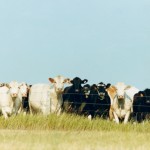Dairy Farmers Struggle To Make It In A Global Marketplace
If dairy farmers could predict their monthly profits or losses, the industry would likely be a more stable place. But as StateImpact Idaho reported last year, that uncertainty (among other things) is making the industry a tough place to do business.
NPR‘s ‘Planet Money‘ co-founder and economics writer for The New York Times Magazine, Adam Davidson, revisited the struggle many dairy farms have. While technology has made it more efficient to milk hundreds or thousands of dairy cows, the profit margins have changed dramatically. Dairy products and feed for the cows are now globally traded commodities.
Davidson introduces us to three generations of dairy farmers in New Jersey. The Fulper family has grown from a tiny depression-era farm to a small modern operation. Davidson writes, “The modern dairy farm, it turns out, represents many of the volatile and confusing trends that have roiled the U.S. economy over the last decade.”
“This, despite the fact that dairy farming has become shockingly more productive. When Bob was a kid, during the Depression, he and his 10 siblings milked the family’s 15 cows by hand and produced 350 pounds’ worth of milk per day. By the time Robert was a teenager, in the 1970s, the farm had grown to 90 cows — all of which were milked automatically through vacuum technology — and sold around 4,000 pounds of milk per day. Now the Fulpers own 135 cows, which produce more than 8,000 pounds of milk.
So the farm should be more lucrative, right? Robert showed me exactly how much money he and his brother made last year, an unusually profitable one for the dairy industry. He asked me not to reveal the number, but let’s put it this way: Robert and Fred start work at 4:30 a.m., finish at 7 p.m. and trade Sundays off. If you divide their 2011 profit by their weekly hours, they earn considerably less than minimum wage.” – NYTimes.com
This story is probably something many Idaho dairy farmers can relate to. Never-ending work and no guaranteed monthly paycheck. The effects of going from a local industry to a global one are multifaceted. Davidson explains:
“[F]or decades, the U.S. government enforced stable prices for feed and for milk, which meant steady, predictable income, shaken only by disease or bad weather. “You could project your income within 5 to 10 percent without trying too hard,” says Alan Zepp, a dairy-farm risk manager in Pennsylvania.
But by the early aughts, to accommodate global trade rules and diminishing political support for agricultural subsidies, the government allowed milk prices to follow market demand. People in other parts of the world — notably China and India — also became richer and began demanding more meat and dairy products. Animal feed, especially corn and soybeans, became globally traded commodities with all the impossible-to-predict price swings of oil or copper. Today Robert can predict his profit or loss next month with all the certainty that you or I can predict the stock market or gas prices. During my visit, Robert said that his success this year will be determined by, among other things, China’s unpredictable economic growth, the price of gas (influenced, of course, by events in Iran and Syria) and the weather in New Zealand (a major milk exporter), where a drought can send prices skyrocketing.” – NYTimes.com
You can read Davidson’s full story here. And meet a couple of Idaho dairy farmers here.


